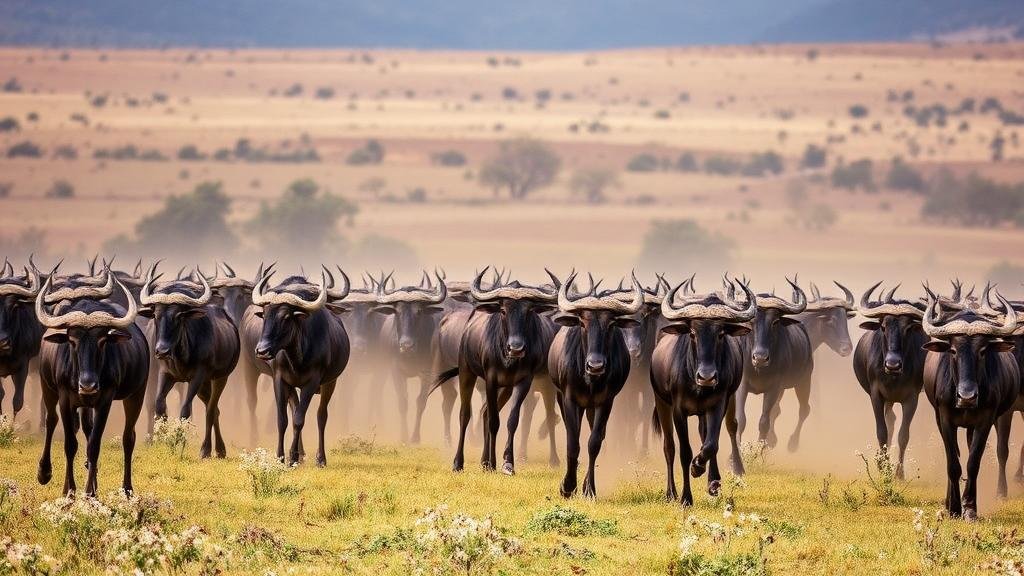Following the migration of the Serengeti wildebeest: nature’s greatest journey.
Following the Migration of the Serengeti Wildebeest: Natures Greatest Journey
The Serengeti migration, featuring one of the largest terrestrial mammal migrations in the world, provides a spectacular display of nature’s intricate dance for survival. Each year, approximately 1.5 million wildebeest, alongside hundreds of thousands of zebras and gazelles, embark on a life-sustaining journey across the Serengeti ecosystem in Tanzania and into the Maasai Mara in Kenya. Their migration is driven by the search for fresh grazing and water, which plays a vital role in maintaining the ecological balance of the region.
The Journey: Timing and Routes
The wildebeest migration is cyclical and closely tied to the seasonal weather patterns of East Africa. Typically, this incredible journey can be broken down into different stages:
- Calving Season (February to March): The migration begins with the calving of around 500,000 baby wildebeest. This is crucial for ensuring the survival of the species, as most calves are born within a three-week period to allow for predator confusion.
- Eastern Serengeti (April to May): After calving, the herds migrate northeast toward the lush grasslands of the eastern Serengeti, where they graze and gain strength.
- Grumeti River Crossing (June): As the herds move north, they encounter the Grumeti River, a perilous point where crocodiles lie in wait, leading to dramatic scenes of survival.
- Maasai Mara (July to October): The migration reaches the Maasai Mara in Kenya, where wildebeest continue foraging before facing the challenge of crossing back into Tanzania.
- Return Trek (November to December): As rainfall begins to fall in Tanzania, herds head back south, rejuvenating the Serengeti grasslands for future cycles.
Ecological Impact of the Migration
The Serengeti wildebeest migration has significant ecological ramifications. As the wildebeest graze their way through the savannah, they contribute to nutrient cycling, which enhances the soil quality for subsequent plant growth. This is essential for keeping the ecosystem balanced and supporting various other species that depend on this environment.
Also, this mass movement serves as a crucial food source for numerous predators, including lions, hyenas, and crocodiles, demonstrating the interconnectedness of the ecosystem. The presence of large ungulates also influences the behavior and distribution of other wildlife species, ensuring biodiversity within the region.
Threats to the Migration
Despite its natural grandeur, the Serengeti migration faces several threats that could jeopardize this vital ecological phenomenon:
- Climate Change: Altered weather patterns significantly impact the timing of the rainy seasons, posing risks to the traditional migration routes and food availability.
- Human Encroachment: Agricultural expansion and infrastructure development intrude upon the migration pathways, disrupting the cycles and potentially causing fatal accidents for the animals.
- Trophy Hunting and Poaching: Increased hunting pressure adversely affects herd numbers and can disrupt mating patterns and population dynamics.
Conservation Efforts
Recognizing the importance of the wildebeest migration, various organizations are working to safeguard this natural spectacle. Initiatives such as:
- The Serengeti National Park: Established in 1951, the park serves as a critical habitat for the wildebeest and the biodiversity of the Serengeti ecosystem.
- The Maasai Mara National Reserve: This protected area in Kenya is crucial for supporting migratory species and discouraging illegal hunting.
- Community Engagement Programs: Local communities educated and involved in conservation methods, ensuring the protection of wildlife and their habitats is a shared responsibility.
Experiencing the Migration
For those interested in witnessing this breathtaking event, there are numerous eco-tourism opportunities available. Guided safaris provide a unique experience, offering insights into the behavior of wildebeests and their interactions with the environment. Popular viewing areas include:
- The River Crossings: These thrilling moments are best observed during the peak months from July to October at strategic river crossings.
- The Calving Grounds: From late January to early March, visiting the southern Serengeti provides an opportunity to see newborn calves and the ensuing natural drama with predators.
Conclusion
The migration of the Serengeti wildebeest is a remarkable natural phenomenon that highlights the intricate balance of life in one of the worlds most celebrated ecosystems. Understanding the significance of this journey–not just for the wildebeests, but for the entire region–can inspire a collective effort to protect and preserve this vital resource for future generations. Whether through sustainable tourism, conservation efforts, or supporting local initiatives, every action counts toward ensuring that this spectacle of nature continues to thrive.



